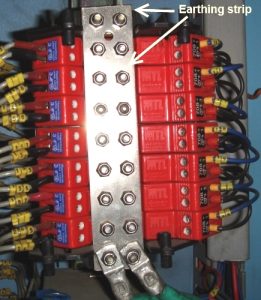Introduction
Intrinsic Safety is a method of protection used in hazardous areas to prevent ignition. In order to achieve this, we use a device known as an intrinsic safety barrier. This safety barrier could be a zener barrier or a galvanic isolator.
This safety barrier sits between the hazardous area device (such as a transmitter, sensor or valve positioner) and the control room side control instrument (could be a single loop controller or input/output card of a DCS or PLC or SIS).
How does a Safety Barrier work?

The barrier ensures that no excess current or voltage reaches the hazardous area. How is this achieved? By using either a Zener Barrier or a galvanic isolator. In this tutorial, we will explain only about the zener barrier. Other pages on this site will explain galvanic isolation.
What is a Zener Barrier? How does it work?

The above picture shows zener barriers mounted on a DIN rail in a marshalling panel in the control room. Note that the earthing is a key component of the entire system of protection and it has to be robust and regularly tested.
In a Zener Barrier, we have a combination of a Zener diode, resistors and fuses to achieve this current and voltage limiting function. If you recollect from basic electronics, a zener diode allows current flow in only one direction if it is forward biased (and in this condition it behaves exactly like a normal bijunction diode). However in case of reverse bias, the bi junction diode simply does not conduct. A zener on the other hand does not conduct only until the reverse voltage is within a limit. As soon as we apply a reverse voltage that is higher than the breakdown voltage of the zener, it starts conducting current. And once it does so the current keeps on increasing, while the voltage remains constant, like a voltage regulator. The following circuit shows a typical zener diode schematically.

In a zener barrier, the excess current if received on the control room side, gets diverted to ground and only a safe level of voltage appears across the hazardous area terminals of the device. In case the current is more than can be handled by the diode the fuse will blow, protecting the circuit.
Are there any other ways of explosion protection in hazardous areas?
Of course there are many other ways of explosion protection used in hazardous areas. The two most popular ones, used for Instrumentation and Automation systems are explosionproof and Intrinsic Safety. if you are wondering which technique to use then you can refer to this guide Intrinsic Safety or Explosionproof here.
More Information
To know in detail about how zener barriers work, you can take the Hazardous Area Instrumentation e-learning course or the Intrinsic Safety e-learning course.